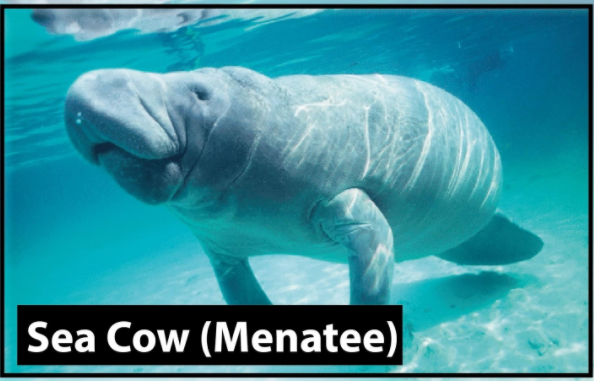
In Sea Cow / Manatee
(a) Hind limbs are absent
(b) Fire limbs are modified into paddles
(c) Tail has fin
(d) All the above
Answer
492.9k+ views
Hint: They are aquatic and semi-aquatic mammals that live mostly in water bodies. Their characteristic features include flippers-like forelimbs that help them in swimming. They belong to the order Sirenians.
Complete answer:
The Sea Cow / Manatee belongs to the Order Sireniana whose characteristic feature is the absence of hindlimbs, with forelimbs modified into paddles and tails consisting of fins that help them in swimming in water bodies.

- They are aquatic mammals that live in water bodies full time.
- They are herbivorous in nature that lives in rivers, swampy areas, wetlands, coasts, etc.
- The body of sea cows is found to be fusiform-shaped, and large that helps them drag their body in the water.
- The density of their bones is greater to match the buoyancy of their blubber which is thin in the layer.
- The sea cows are found to be quite sensitive to the temperature, as the temperature drops too low they start migrating.
- They are slow-moving creatures, and consume foods especially seagrasses with the help of their large lips.
- The male Sireniana show polygyny where one male mates with several female sirenians.
- They are said to have the vestigial pelvis and there is no evidence of them having any foot bones or skeletal system in reference to the legs.
- Their skin is tough and hairless, having sensory hairs on it called vibrissae.
So, the correct answer is ‘All the above’.
Note: The word Sirenians was derived from the ancient Greek mythological word, sirens. Seekoi is also the word for the Sea cow but in Africa, it is used to refer to Hippopotamus. The Sirenians are said to have evolved in the early Eocene era and are found to live in the New World.
Complete answer:
The Sea Cow / Manatee belongs to the Order Sireniana whose characteristic feature is the absence of hindlimbs, with forelimbs modified into paddles and tails consisting of fins that help them in swimming in water bodies.

- They are aquatic mammals that live in water bodies full time.
- They are herbivorous in nature that lives in rivers, swampy areas, wetlands, coasts, etc.
- The body of sea cows is found to be fusiform-shaped, and large that helps them drag their body in the water.
- The density of their bones is greater to match the buoyancy of their blubber which is thin in the layer.
- The sea cows are found to be quite sensitive to the temperature, as the temperature drops too low they start migrating.
- They are slow-moving creatures, and consume foods especially seagrasses with the help of their large lips.
- The male Sireniana show polygyny where one male mates with several female sirenians.
- They are said to have the vestigial pelvis and there is no evidence of them having any foot bones or skeletal system in reference to the legs.
- Their skin is tough and hairless, having sensory hairs on it called vibrissae.
So, the correct answer is ‘All the above’.
Note: The word Sirenians was derived from the ancient Greek mythological word, sirens. Seekoi is also the word for the Sea cow but in Africa, it is used to refer to Hippopotamus. The Sirenians are said to have evolved in the early Eocene era and are found to live in the New World.
Recently Updated Pages
Master Class 11 Economics: Engaging Questions & Answers for Success

Master Class 11 Business Studies: Engaging Questions & Answers for Success

Master Class 11 Accountancy: Engaging Questions & Answers for Success

Master Class 11 English: Engaging Questions & Answers for Success

Master Class 11 Computer Science: Engaging Questions & Answers for Success

Master Class 11 Maths: Engaging Questions & Answers for Success

Trending doubts
State and prove Bernoullis theorem class 11 physics CBSE

1 ton equals to A 100 kg B 1000 kg C 10 kg D 10000 class 11 physics CBSE

State the laws of reflection of light

One Metric ton is equal to kg A 10000 B 1000 C 100 class 11 physics CBSE

Difference Between Prokaryotic Cells and Eukaryotic Cells

1 Quintal is equal to a 110 kg b 10 kg c 100kg d 1000 class 11 physics CBSE




